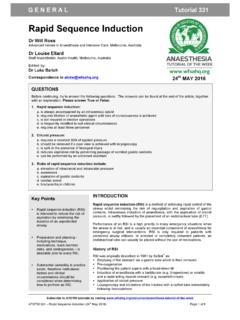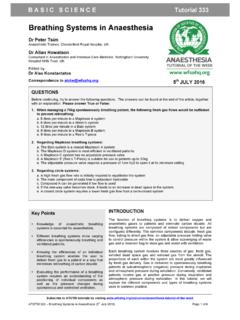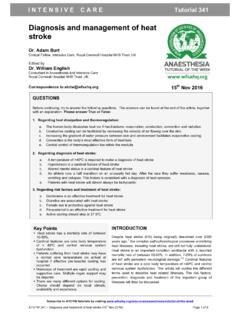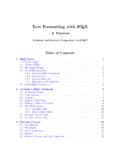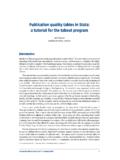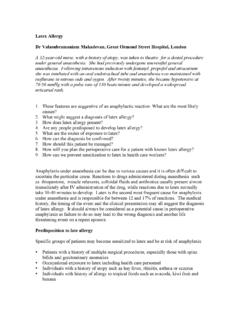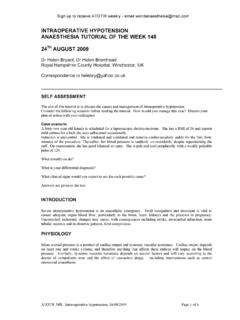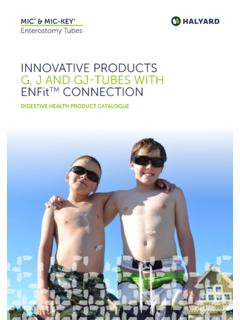Transcription of 324 An Update on Perioperative Anaphylaxis
1 GENERAL ANAESTHESIA Tutorial 324. An Update on Perioperative Anaphylaxis . Dr. Rebecca Yim Resident Anaesthesiologist, Queen Mary Hospital, Hong Kong Edited by Dr. Clara Ching Mei Poon Correspondence to 18th JAN 2016. QUESTIONS. Before continuing, try to answer the following questions. The answers can be found at the end of the article, together with an explanation. Please answer True or False: 1. In the diagnosis of Anaphylaxis : a. Suxamethonium and atracurium are the neuromuscular blocking agents most commonly associated with Anaphylaxis b. Mucocutaneous signs are a diagnostic feature in patients with Anaphylaxis c. Hypotension with tachycardia is always present in severe reactions d. A single sample of elevated plasma total tryptase is diagnostic of Anaphylaxis e. Tryptase levels may be elevated more than 24 hours after the Anaphylaxis episode 2.
2 In the management of Anaphylaxis : a. Adrenaline may be less effective in patients on beta-blockers, so glucagon should be considered as a first line intervention in these patients b. Intravenous antihistamines do not affect the clinical outcome and may increase the risk of hypotension and tissue necrosis c. An initial intravenous dose of 100 micrograms of adrenaline should immediately be administered in all adults presenting with intraoperative Anaphylaxis d. Steroids have been shown to improve clinical outcome when administered early e. The patient should be admitted to intensive care for close monitoring 3. Preventative management strategies for a patient with a recent episode of Anaphylaxis include: a. Referral to an immunologist or specialised laboratory for skin testing b. Skin testing because a positive result will help to verify the cause of Anaphylaxis c.
3 Prompt skin testing as soon as the patient has recovered from the anaphylactic event d. A desensitisation process if no other alternative medication can be used e. Education on avoidance of suspected triggers and recognition of signs and symptoms of Anaphylaxis Key Points INTRODUCTION. Early recognition and administration of adequate adrenaline is the mainstay of Anaphylaxis management. Anaphylaxis is a rare and potentially fatal complication Steroids and antihistamines should not be used in the with a wide spectrum of clinical presentations. The initial management of Anaphylaxis . ability to recognise and treat it in the Perioperative setting is imperative for every anaesthesiologist. Anaphylaxis is a clinical diagnosis, and tests such as According to the European Academy of Allergy and total plasma tryptase are only supportive of the Clinical Immunology, Anaphylaxis is defined as a diagnosis.
4 Severe, potentially life-threatening systemic 1. hypersensitivity reaction. The estimated incidence of The anaesthesiologist plays a key role in coordinating Perioperative Anaphylaxis is 1 in 10,000 20,000. care for the patient during and after a Perioperative 2. anaesthetic procedures, with the overall mortality rate Anaphylaxis event. for Anaphylaxis being less than 1. Subscribe to ATOTW tutorials by visiting th ATOTW 324 An Update on Perioperative Anaphylaxis (18 Jan 2016) Page 1 of 6. PATHOPHYSIOLOGY. Anaphylaxis can be caused by immunological mechanisms (IgE-mediated or non-IgE-mediated), non-immunological mechanisms, or be idiopathic. A small quantity of allergen is sufficient to stimulate immune cells and cause Anaphylaxis . The clinical diagnosis and management of Anaphylaxis is the same regardless of the underlying mechanism.
5 Immunological mechanisms of Anaphylaxis involve the production of immunoglobulins. IgE-mediated Anaphylaxis is caused by the cross-linking of IgE resulting in degranulation of mast cells and basophils. Upon exposure to an allergen, there is activation of TH2 cells that stimulate the production of IgE antibodies. The IgE binds to Fc RI receptors on the surface of mast cells and basophils causing sensitisation of these cells. This initial sensitisation has no clinical manifestation. When there is re-exposure to the allergen, the receptor-bound IgE aggregates and stimulates sensitised mast cells and basophils to degranulate. This degranulation results in the release of mediators such as histamine, prostaglandins, proteoglycans, and cytokines, leading to the clinical manifestations of Anaphylaxis . In non-IgE-mediated Anaphylaxis , the hypersensitivity reaction is stimulated through other mechanisms including IgG and immune complex 3.
6 Complement-mediated pathways. The non-immunological mechanism of Anaphylaxis does not involve immunoglobulins and is due to direct stimulation of mast cells by the causative agent drugs, cold, and exercise. Similarly, there is degranulation of mast cells and release of mediators such as histamine. In the Perioperative setting, this may be associated with drugs such as opioids, vancomycin, and neuromuscular blocking agents ( atracurium), and is usually transient and may present with just cutaneous signs. Idiopathic Anaphylaxis is only diagnosed when no specific allergen can be identified from history or skin tests, and there is absence of elevation in serum specific IgE levels. RISK FACTORS and TRIGGERS. Risk factors for Anaphylaxis include a history of atopy, drug or food allergy, multiple operations, systemic mastocytosis, and hereditary angioedema.
7 Common Perioperative triggers of Anaphylaxis include neuromuscular blocking agents, antibiotics (most commonly beta-lactam antibiotics), and latex. Less commonly, Anaphylaxis may be provoked by 4. chlorhexidine, colloids, blue dyes (isosulfan, patent blue V), heparin, protamine, and oxytocin. Chlorhexidine can be found in many products such as skin preparations and wipes, lubricant gels, and impregnated central venous lines and hence all the above should be avoided in patients with documented chlorhexidine allergy. It is rare for opioids or hypnotic agents (barbiturates, propofol, etomidate) to be the source of Anaphylaxis . The neuromuscular blocking agents most commonly associated with Anaphylaxis are rocuronium and suxamethonium. Anaphylaxis occurs due to IgE sensitisation towards the quarternary ammonium groups in the neuromuscular blocking agents.
8 In a retrospective study conducted by Sadleir et al. over a ten year period in Western Australia, it was noted that amongst the eighty patients diagnosed with life-threatening Anaphylaxis to a non-depolarising neuromuscular blocking drug, 56% had a reaction towards rocuronium with an incidence of 8 Anaphylaxis episodes per 100,000 administrations (95% CI 11/100,000). Cross-reactivity with other non-depolarising neuromuscular blocking agents is also highest with rocuronium and suxamethonium. In the study, patients with Anaphylaxis to rocuronium had cross-reactivity rates of 44% with suxamethonium, 40% with vecuronium, 20% with atracurium, and 5% with cisatracurium. Cross-reactivity rates in patients with Anaphylaxis to suxamethonium were 24% with rocuronium, 12% with vecuronium, and 6% with 5. atracurium. DIAGNOSIS.
9 Anaphylaxis is a clinical diagnosis. Laboratory tests are not useful in diagnosing Anaphylaxis at the time of presentation 6. because they take time to process and are prone to false negatives and positives. Patients may present with acute onset of generalised mucocutaneous signs, respiratory compromise, and cardiovascular instability. These signs may present in isolation or in any combination. Diagnosing Anaphylaxis can be difficult because these signs may also arise from other anaesthetic, surgical, or patient-related factors in the Perioperative setting. Anaphylaxis should be suspected if there is unexplained hypotension refractory to vasopressors, or unexplained difficulty in ventilation and bronchospasm. The severity of Anaphylaxis can be graded from the mildest presentation of generalised mucocutaneous signs to the most severe form with cardiopulmonary arrest.
10 Cutaneous signs may not be evident in all anaphylactic reactions and appear only after hypotension has been treated and cutaneous perfusion restored. Patients also may not have 2. tachycardia with hypotension but instead bradycardia due to the Bezold Jarisch reflex in severe hypovolaemia. It has been suggested that Anaphylaxis can be graded clinically, as adapted from the Ring and Messmer four-step 7. grading scale (Figure 1). Differential diagnoses of Anaphylaxis include exacerbation of asthma, tension pneumothorax, myocardial ischaemia, pulmonary embolism, C1 esterase deficiency, mastocytosis and clonal mast cell disorders. Subscribe to ATOTW tutorials by visiting th ATOTW 324 An Update on Perioperative Anaphylaxis (18 Jan 2016) Page 2 of 6. Grade Summary Specific signs and symptoms Erythema Grade 1 Generalised mucocutaneous signs Urticaria Angioedema Mucocutaneous signs Grade 2 Multi-organ manifestations Bronchospasm Hypotension Arrhythmia Severe life threatening multi-organ Cardiovascular collapse Grade 3.
